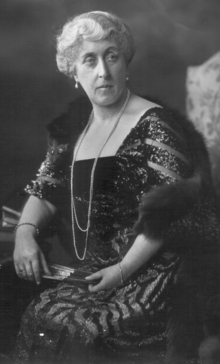Princess Helena Victoria of Schleswig-Holstein
| Princess Helena Victoria | |||||
|---|---|---|---|---|---|
| Princess Helena Victoria of Schleswig-Holstein | |||||
 Princess Helena Victoria, in 1920 | |||||
| Born |
3 May 1870 Frogmore House, Windsor, England | ||||
| Died |
13 March 1948 (aged 77) Berkeley Square, London | ||||
| Burial | Frogmore, Windsor | ||||
| |||||
| House | Schleswig-Holstein-Sonderburg-Augustenburg | ||||
| Father | Prince Christian of Schleswig-Holstein | ||||
| Mother | Princess Helena of the United Kingdom | ||||
Princess Victoria Louise Sophia Augusta Amelia Helena of Schleswig-Holstein (3 May 1870 – 13 March 1948), known as Princess Helena Victoria, was a granddaughter of Queen Victoria of the United Kingdom.
Early life
Princess Helena Victoria (always known to her family as Thora) was born at Frogmore House, near Windsor Castle. Her father was Prince Christian of Schleswig-Holstein, the third son of Christian, Duke of Augustenburg and Countess Louise af Danneskjold-Samsøe. Her mother was Princess Helena, the fifth child and third daughter of Queen Victoria and Prince Albert of Saxe-Coburg and Gotha. Her parents resided in Britain from marriage. She was a bridesmaid at the 1885 wedding of Queen Victoria’s youngest daughter Princess Beatrice to Prince Henry of Battenberg.[1] She was a bridesmaid at the wedding of the Duke and Duchess of York (future George V and Queen Mary) on 6 July 1893. [2]
She spent most of her childhood at Cumberland Lodge, her father's residence as Ranger of Windsor Great Park. Known to her family as "Thora", or sometimes "Snipe", in reference to her sharp facial features, formally she used the names "Helena Victoria" from among her string of six given names.
World War I
In July 1917, King George V changed the name of the British royal family to the House of Windsor. He also relinquished, on behalf of himself and his numerous cousins who were British subjects, the use of their German titles, styles, and surnames. Princess Helena Victoria and Princess Marie Louise thereupon ceased to use the territorial designation "of Schleswig-Holstein-Sonderburg-Augustenburg." Instead, they became known simply as "Her Highness Princess Helena Victoria" and "Her Highness Princess Marie Louise". Although the two had borne German titles, their upbringing and domicile were entirely English.
Later life
Princess Helena Victoria never married. She followed her mother's example in working for various charitable organizations, most notably the Young Men's Christian Association (YMCA), Young Women's Christian Association (YWCA) and Princess Christian's Nursing Home at Windsor. During World War I, she founded the YWCA Women's Auxiliary Force. As its president, she visited British troops in France and obtained the permission of the Secretary of State for War, Lord Kitchener, to arrange entertainments for them. Between the world wars, she and her younger sister, Princess Marie Louise, were enthusiastic patrons of music at Schomberg House, their London residence. After a German air raid damaged the house in 1940, the two princesses moved to Fitzmaurice Place, Berkeley Square.
In ill health and using a wheelchair after World War II, one of Princess Helena Victoria's last major appearance was at the 20 November 1947 wedding of her first cousin twice removed Princess Elizabeth, to Prince Philip of Greece and Denmark. [3]
Princess Helena Victoria died at Fitzmaurice Place, Berkeley Square. Her funeral took place at St. George's Chapel, Windsor and she was buried at the Royal Burial Ground, Frogmore, Windsor Great Park. She died at the age of 77, the same age at which her mother, Princess Helena, had also died.
Titles, styles, honours and arms
| Royal styles of Princess Helena Victoria | |
|---|---|
 | |
| Reference style | Her Highness |
| Spoken style | Your Highness |
| Alternative style | Ma'am |
Titles
- 1870–1917: Her Highness Princess Helena Victoria of Schleswig-Holstein
- 1917–1948: Her Highness Princess Helena Victoria
As a male-line granddaughter of the Duke of Schleswig-Holstein, Princess Helena Victoria would have been styled Serene Highness (Durchlaucht). In May 1866, Queen Victoria had conferred the higher style of Highness upon any children to be born of the marriage of Princess Helena and Prince Christian, although the children were to remain Prince or Princess of Schleswig-Holstein, the Highness form of address being only in legal effect in the United Kingdom, not in Germany. In June 1917, a notice appeared in the Court Circular that a Royal Warrant was to be prepared by George V dispensing with his cousins' use of the "Schleswig-Holstein-Sonderburg-Augustenburg" part of their titles. However no warrant was issued, nor were they formally granted the titles of Princesses of Great Britain and Ireland nor of the United Kingdom.[4]
Honours
British honours
- VA: Lady of the Order of Victoria and Albert (1883)
- CI: Lady of the Order of the Crown of India (1889)
- GBE: Dame Grand Cross of the Order of the British Empire (1918)
- GCStJ: Dame Grand Cross of the Order of St John (1928)
Foreign honours
Ancestry
Notes
- ↑ NPG: Prince and Princess Henry of Battenberg with their bridesmaids and others on their wedding day http://www.npg.org.uk/collections/search/portrait/mw145863/Prince-and-Princess-Henry-of-Battenberg-with-their-bridesmaids-and-others-on-their-wedding-day?LinkID=mp89748&role=art&rNo=2
- ↑ "'The Duke and Duchess of York and Bridesmaids'". National Portrait Gallery, London.
- ↑ Royal Collection: Seating plan for the Ball Supper Room http://www.royalcollection.org.uk/microsites/royalwedding1947/object.asp?grouping=&exhibs=NONE&object=9000366&row=82&detail=magnify
- ↑ This led to their being mockingly referred to as 'The Princesses of Nothing' by their cousin Victoria Mountbatten, Marchioness of Milford Haven, née Princess of Hesse and by Rhine, as her granddaughter Pamela Hicks records in her memoir "Daughter of Empire" (London 2012), p. 161.
Sources
- Ronald Allison and Sarah Riddell, eds., The Royal Encyclopedia (London: Macmillan, 1992).
- "Obituary: Princess Helena Victoria, Charity and Social Services," 15 March 1948, p. 7.
- "Royal Titles: German Names Dropped, British Peerages for Princes," The Times 20 July 1917, p. 7.